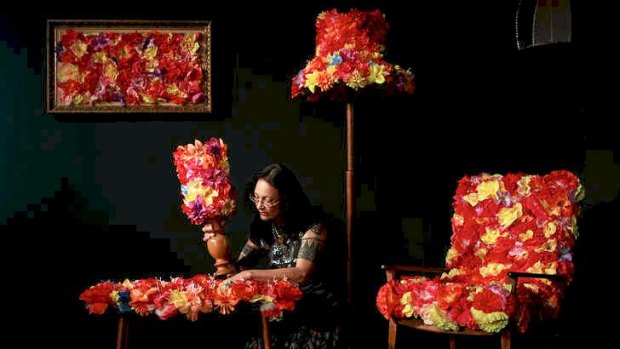By Lisa Havilah
Western Sydney is the future cultural face of Australia.
It is a place that thinks about Australia as part of a larger, more connected whole.

Niki Hastings-McFall installs her work Lounge (polynisation series 2013) at Campbelltown Arts Centre earlier this year.Credit: Jacky Ghossein
Its demographic is young. It is home to an infinite number of culturally specific communities, who are more naturally connected internationally than they are across suburbs.
Western Sydney is a place talked about through statistics: it is home to 10 per cent of Australia's population; it will outnumber the rest of Sydney within 14 years; almost half of the population was born overseas.
It is a place of extreme wealth and extreme poverty, side by side, next to freeways, in suburbs, behind fences.
The Packer Gift of $30 million to arts and culture in Western Sydney is a strong acknowledgement of the importance of the region.
In 1999 the NSW government in partnership with local government established the Western Sydney Arts Strategy. The first phase of this strategy was a $55 million investment in infrastructure, which resulted in the establishment and growth of major multi-arts centres including Campbelltown Arts Centre, Casula Powerhouse, Blacktown Arts Centre, Penrith Regional Gallery and Penrith Performing and Visual Arts.
The other key component of this strategy was the bringing together of all tiers of government to leverage further investment into distinctive culturally engaged arts programs that engaged communities. This resulted in investment into the arts from other sections of government including health and housing - a practice that still continues. The art programs that are being made in Western Sydney are culturally relevant, locally engaged and artistically excellent.
I was lucky enough to work in Western Sydney between 1999 and 2010 and witnessed firsthand the impact that a strategic multi-year, cross government approach to investment in the arts can make. I saw the impact that it had on establishing careers for artists and providing pathways for young people into the arts.
The delivery of the strategy supported a much-needed diversity within NSW and Australia to grow a particular model of contemporary arts practice. The achievements of the Western Sydney Arts Strategy cannot be underestimated and its focus of trying to achieve equity with the rest of NSW continues.
Today the arts in Western Sydney needs help. Local government is straining under the pressure of population growth, service provision and the politics of rate increases. It is critical that we acknowledge that governments can't sustain the arts alone. The success of investment into the arts will come from ensuring that there is a diverse mix of private sector and government support. Philanthropy is a critically important part of this mix.
The Packer Gift has the potential to leave a great legacy. It can achieve this if it is distributed strategically and in line with locally generated priorities that have been identified by the institutions, governments and communities that live within the region.
I hope that the Packer Gift can trigger a culture of philanthropy in Western Sydney. I hope that it will inspire the many individuals and businesses that have benefited and continue to benefit from the ongoing economic and population growth of the region. I hope that the impact of the Packer Gift is cumulative so that the new and existing communities of Western Sydney can experience the very best in arts within their own city, their own suburb, or their own street.
Lisa Havilah is the director of Carriageworks, Sydney. She is a former assistant director of the Casula Powerhouse and former director of the Campbelltown Arts Centre.